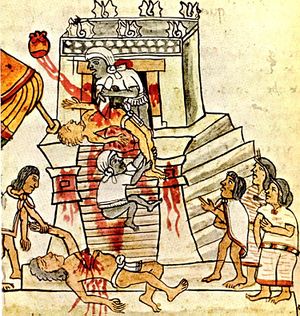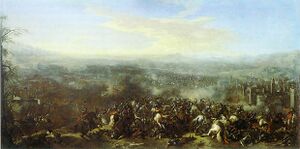الإمبراطورية الإسپانية
الامبراطورية الاسبانية | |
|---|---|
 العلم | |
 المناطق من العالم التي كانت في وقت ما جزءاً من الإمبراطورية الإسبانية. | |
أراض خـُسرت قبل أو أثناء حروب الاستقلال الأمريكية الاسبانية (1811-1828).
أراض خـُسرت عقب الحرب الاسبانية الأمريكية (1898-1899).
أراضي مُنِحت الاستقلال أثناء إزالة استعمار أفريقيا (1956-1976).
أراضي تديرها حالياً اسبانيا. |
الإمبراطورية الإسپانية (إسپانية: Imperio Español) تكونت من الأراضي والمستعمرات المدارة مباشرة من قِبل اسبانيا في اوروبا والأمريكتين وأفريقيا وآسيا واوقيانوسيا. وفي أوج قوتها، كانت أحد أكبر الامبراطوريات في تاريخ العالم، وأحد أول الامبراطوريات العالمية. وقد استمرت من القرن 15 وحتى أواخر القرن العشرين (لممتلكاتها في أفريقيا). وقد برزت اسبانيا كمملكة موحدة في 1492 إثر حروب الاستعادة من المسلمين بشبه جزيرة أيبريا؛ وفي نفس العام، قاد كرستوفر كولومبس أول رحلة بحرية استكشافية اسبانية عبر المحيط الأطلسي، الأمر الذي أدى إلى استعمار اوروبا للأمريكتين. وبذلك أصبح نصف الكرة الغربي محور اهتمام التاج الاسباني.
. . . . . . . . . . . . . . . . . . . . . . . . . . . . . . . . . . . . . . . . . . . . . . . . . . . . . . . . . . . . . . . . . . . . . . . . . . . . . . . . . . . . . . . . . . . . . . . . . . . . . . . . . . . . . . . . . . . . . . . . . . . . . . . . . . . . . . . . . . . . . . . . . . . . . . . . . . . . . . . . . . . . . . . .
أصول الامبراطورية (1402–1521)
الشمس لا تغرب عنها (1521–1643)
حصار تنوشتيتلان وفتح إمبراطورية الإنكا واكتشاف الفلپين (1519–1541)



قوانين جديدة لسلام أوگسبورگ (1542–1555)

سانت كوينتن إلى لپانتو (1556–1571)

"الرب إسپاني" (1596–1626)


الطريق إلى روكروا (1626–1643)

رخاء القرن 18

. . . . . . . . . . . . . . . . . . . . . . . . . . . . . . . . . . . . . . . . . . . . . . . . . . . . . . . . . . . . . . . . . . . . . . . . . . . . . . . . . . . . . . . . . . . . . . . . . . . . . . . . . . . . . . . . . . . . . . . . . . . . . . . . . . . . . . . . . . . . . . . . . . . . . . . . . . . . . . . . . . . . . . . .
غروب الإمبراطورية العالمية (1800–1899)

الأراضي في أفريقيا (1885-1975)
في 1778، تنازل البرتغاليون عن جزيرة فرناندو پو (الآن بيوكو)، والجزيرات المجاورة، والحقوق التجارية للبر الرئيسي بين نهري النيجر واوگوه لاسبانيا مقابل أراضي في أمريكا الجنوبية (معاهدة إل پاردو). وفي القرن 19، قام بعض المستكشفين والمبشرين الأسبان بعبور تلك المنطقة، وكان منهم مانويل ده إرادييه.
في 1848، احتلت القوات الاسبانية Islas Chafarinas.
في 1860، بعد حرب تطوان، تنازل المغرب عن سيدي إفني لاسبانيا كجزء من معاهدة طنجة، على أساس الثغر القديم سانتا كروز دلا مار پكوينيا، الذي اُعتـُقِد أنه سيدي إفني. العقود التالية من التآمر الفرنسي الاسباني نتج عنها تأسيس وتوسيع المحميات الاسبانية جنوب المدينة، وقد حصل النفوذ الاسباني على اعتراف دولي في مؤتمر برلين عام 1884: أدارت اسبانيا سيدي إفني والصحراء الغربية معاً. Spain claimed a protectorate over the coast of Guinea from Cape Bojador to Cap Blanc, too. ريو موني became a protectorate in 1885 and a colony in 1900. Conflicting claims to the Guinea mainland were settled in 1900 by the معاهدة باريس.
وبعد حرب الريف القصيرة، في 1893، وسعت اسبانيا نفوذها جنوباً من مليلة.
وفي 1911، كانت المغرب مقسمة بين فرنسا واسبانيا. وقد ثار أمازيغ الريف rebelled, led by Abdelkrim, a former officer for the Spanish administration. The Battle of Annual (1921) was a sudden, grave, and almost fatal, military defeat suffered by the Spanish army against Moroccan insurgents. A leading Spanish politician emphatically declared: "We are at the most acute period of Spanish decadence".[بحاجة لمصدر] The statement reflected the mood of the country. The rebellion exposed the utter corruption and incompetence of the military and destabilised the Spanish government, leading to dictatorship. A campaign in conjunction with the French suppressed the Rif rebels by 1925 but at a terrible cost to both sides. In 1923, طنجة was declared an international city under French, Spanish, British, and later Italian joint administration. The African army, led by a veteran of the Moroccan campaign, فرانسيسكو فرانكو, started the Spanish Civil War (1936–39). Between 1926 and 1959, Bioko and Rio Muni were united as the colony of غينيا الاسبانية. During the Second World War the Vichy French presence in Tangier was overcome by that of Francoist Spain.
Spain lacked the wealth and the interest to develop an extensive economic infrastructure in her African colonies during the first half of the 20th century. However, through a paternalistic system, particularly on Bioko Island, Spain developed large cocoa plantations for which thousands of Nigerian workers were imported as laborers. The Spanish also helped Equatorial Guinea achieve one of the continent's highest literacy rates and developed a good network of health care facilities.[بحاجة لمصدر]
وفي 1956، عندما أصبح المغرب الفرنسي مستقلاً، سلـَّمت اسبانيا المغرب الاسباني إلى الأمة الجديدة، إلا أنها احتفظت بالسيطرة على سيدي إفني ومنطقة طرفاية وسبتة ومليلة والصحراء الاسبانية. وقد كان السلطان المغربي (لاحقاً الملك) محمد الخامس مهتماً بتلك الأراضي وغزا الصحراء الاسبانية في 1957 (حرب إفني، أو في اسبانيا، الحرب المنسية la Guerra Olvidada). وفي 1958، تنازلت اسبانيا عن طرفاية لمحمد الخامس وضمت المقاطعات التي كانت منفصلة من قبل، الساقية الحمراء (في الشمال) وريو ده اورو (في الجنوب) لتشكل مقاطعة الصحراء الاسبانية.
الذكرى
انظر أيضاً
الهامش
المصادر
- Anderson, James Maxwell (2000), The History of Portugal, Westport, Connecticut: Greenwood, ISBN 978-0313311062.
- Archer, Christon et al. (2002), World History of Warfare, Lincoln: University of Nebraska Press, ISBN 978-0803244238.
- Brown, Jonathan; Elliott, John Huxtable (1980), A Palace for a King. The Buen Retiro and the Court of Philip IV, New Haven: Yale University Press, ISBN 978-0300025071.
- Kamen, Henry (2003), Empire: How Spain Became a World Power, 1492-1763, New York: HarperCollins, ISBN 0-06-093264-3.
- Lach, Donald F.; Van Kley, Edwin J. (1994), Asia in the Making of Europe, Chicago: University of Chicago Press, ISBN 978-0226467344.
- Lockhart, James; Schwartz, Stuart B. (1983), Early Latin America: A History of Colonial Spanish America and Brazil, Cambridge: Cambridge University Press, ISBN 978-0521299299.
. . . . . . . . . . . . . . . . . . . . . . . . . . . . . . . . . . . . . . . . . . . . . . . . . . . . . . . . . . . . . . . . . . . . . . . . . . . . . . . . . . . . . . . . . . . . . . . . . . . . . . . . . . . . . . . . . . . . . . . . . . . . . . . . . . . . . . . . . . . . . . . . . . . . . . . . . . . . . . . . . . . . . . . .
للاستزادة
- Armstrong, Edward (1902). The emperor Charles V. New York: The Macmillan Company
- Black, Jeremy (1996). The Cambridge illustrated atlas of warfare: Renaissance to revolution. Cambridge: Cambridge University Press. ISBN 0-521-47033-1
- Braudel, Fernand (1972). The Mediterranean and the Mediterranean World in the Age of Philip II, trans. Siân Reynolds. New York: Harper & Row. ISBN 0-06-090566-2
- Fernand Braudel, The Perspective of the World (part iii of Civilization and Capitalism) 1979, translated 1985.
- Brown, Jonathan (1998). Painting in Spain : 1500–1700. New Haven: Yale University Press. ISBN 0-300-06472-1
- Dominguez Ortiz, Antonio (1971). The golden age of Spain, 1516-1659. Oxford: Oxford University Press. ISBN 0-297-00405-0
- Edwards, John (2000). The Spain of the Catholic Monarchs, 1474-1520. New York: Blackwell. ISBN 0-631-16165-1
- Harman, Alec (1969). Late Renaissance and Baroque music. New York: Schocken Books.
- Kamen, Henry (1998). Philip of Spain. New Haven and London: Yale University Press. ISBN 0-300-07800-5
- Kamen, Henry (2005). Spain 1469-1714. A Society of Conflict (3rd ed.) London and New York: Pearson Longman. ISBN 0-582-78464-6
- Parker, Geoffrey (1997). The Thirty Years' War (2nd ed.). New York: Routledge. ISBN 0-415-12883-8
- Parker, Geoffrey (1972). The Army of flanders and the Spanish road, 1567–1659; the logistics of Spanish victory and defeat in the Low Countries' Wars.. Cambridge: Cambridge University Press. ISBN 0-521-08462-8
- Parker, Geoffrey (1977). The Dutch revolt. Cambridge: Cambridge University Press. ISBN 0-8014-1136-X
- Parker, Geoffrey (1978). Philip II. Boston: Little, Brown. ISBN 0-316-69080-5
- Parker, Geoffrey (1997). The general crisis of the seventeenth century. New York: Routledge. ISBN 0-415-16518-0
- Ramsey, John Fraser (1973) Spain: the rise of the first world power. University of Alabama Press. ISBN 0817357041 9780817357047
- Stradling, R. A. (1988). Philip IV and the government of Spain. Cambridge: Cambridge University Press. ISBN 0-521-32333-9
- Thomas, Hugh (2004). Rivers of Gold: The Rise of the Spanish Empire 1490-1522 Weidenfeld & Nicolson. ISBN 0-297-64563-3
- Thomas, Hugh (1997). The Slave Trade; The History of the Atlantic Slave Trade 1440-1870. London: Papermac. ISBN 0-333-73147-6
- Various (1983). Historia de la literatura espanola. Barcelona: Editorial Ariel
- Wright, Esmond, ed. (1984). History of the World, Part II: The last five hundred years (3rd ed.). New York: Hamlyn Publishing. ISBN 0-517-43644-2.
وصلات خارجية
- Library of Iberian Resources Online, Stanley G Payne A History of Spain and Portugal vol 1 Ch 13 "The Spanish Empire"
- The Mestizo-Mexicano-Indian History in the USA
- To Rule the Earth: Sizes of the largest empires in history
- Documentary Film, Villa de Albuquerque
- The last Spanish colonies (بالإسپانية)
- Francisco José Calderón Vázquez (2008). Fronteras, identidad, conflicto e interacción. Los Presidios Españoles en el Norte Africano (in Spanish). ISBN 978-84-691-6786-1.
{{cite book}}: CS1 maint: unrecognized language (link)










